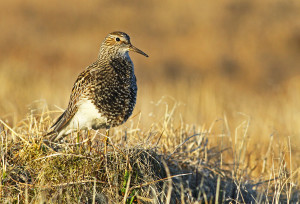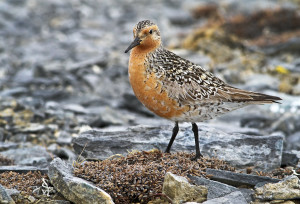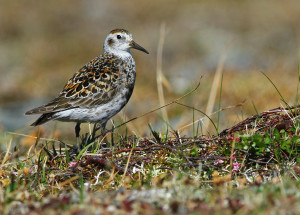More Than Just a Mudsucker

When most birders in North America think of shorebirds, they probably think of little brown and gray birds running around on mudflats. Sure, they may also think of large flocks and the joy of picking through lots of common birds to find some coveted rarity. Or they may even think of colorful juveniles or breeding adults covered in subtly beautiful patterning. Ask them about the voices of shorebirds, and they may think of the challenge of learning shorebirds by call, often considered to be squarely in the realm of advanced birding.
What most of those same birders probably don’t envision when thinking of shorebirds are the complicated and amazing displays they perform on their arctic breeding grounds. What was once a bird that made just a few simple, short chips or churrs suddenly has a large and varied repertoire that includes complicated aerial acrobatics, and sounds as varied as low-pitched hooting to amazingly insect-like twittering. The first time I stood out on the tundra in Alaska I was blown away by everything I was seeing and hearing, and I’ve never looked at shorebirds the same way again.
That’s not to say you have to go to the Arctic to see this amazing show. Most shorebirds have breeding displays of one sort or another, even those breeding in the lower 48. And some migrant species that breed further north will sing and display (usually half-heartedly) on their way up – the species most likely to do this seem to be yellowlegs and dowitchers. But even though you can go to the prairie and watch a Mountain Plover sing while doing a butterfly flight, or see a Long-billed Curlew while it’s traveling in a large, undulating circle over the grasslands while mournfully whistling, they don’t hold quite the same draw as the higher latitude breeding species.

There isn’t nearly enough space here to go into all the different displays and songs from all the different Arctic breeders, so I’ll cover three of my favorites – Red Knot, and Rock and Pectoral Sandpipers. Someday I may write another blog post covering some of the others…there’s no shortage of material to draw on!
I’ll start with Red Knot because perhaps more than any other species it demonstrates how different shorebirds are on their breeding grounds. Generally, when migrating or wintering this species is among the quietest of all shorebirds. Not that it won’t call, but it seems to do it less often, and more softly, than most species. But up on the breeding grounds in Alaska it’s an entirely different beast. Not only does it typically breed far from the nearest mudflat (and sometimes nearest open water!), on barren rocky tundra, but it also has some shockingly loud and strident vocalizations! Its main song (the first of the recordings below) is given during a prolonged (sometimes >30 min) display flight during which it rises high into the air and moves in a large, slow circle while fluttering its wings shallowly and rapidly. It will repeat the same whistle for a long time before suddenly breaking into a different, louder whistle and then returning to the first whistle. The second recording below is an entire flight display, lasting three minutes and starting out with a few other calls before it begins singing.
On the ground Red Knots will make a few other calls. The first two recordings below were both given after playback, and typically included some calls given on a short flight off the ground and others given while perched. I’ve also heard them given during encounters with other Knots, so they likely represent a higher degree of agitation than their normal flight song. The next two recordings are the two different types of alarm calls that I’ve heard, both given by a bird near young, flightless chicks. The first was given during a broken wing display (which many shorebirds have), and the sound is likely meant to mimic the squeals of a hurt mammal and draw potential predators away from the nest or young. The second was made when the same bird was a bit calmer, but still trying to draw my attention away from the nearby chicks.

Next up is a species that most birders aren’t terribly familiar with (unless you live in the Pacific Northwest) – Rock Sandpiper. The west coast equivalent of Purple Sandpiper, this species is typically local and uncommon in the lower 48 during the winter months only, most often found from northern California northward. They also tend to not be very vocal on their wintering grounds, though it isn’t uncommon to hear a rough “churt” when they flush. In Alaska they breed on a variety of tundra habitats (depending on the subspecies), and unsurprisingly have quite a variety of calls and songs. Rock Sandpiper illustrates one of the problems when classifying shorebird vocalizations – what exactly is their “song”? There are three vocalizations that seem to fill that purpose in this species. The first recording below is an example of what is called “Rhythmically Repeated Call” (RRC) in many shorebirds species. It tends to be given during a prolonged flight display in which the bird flutters with shallow wingbeats well of the ground. Actually, RRC is one of the least variable shorebird sounds – for example, compare the one below to the RRC of Baird’s Sandpiper (the first few phrases, and then for longer after the flight songs).
The next two recordings below are what BNA calls the “song” of Rock Sandpiper. It is typically given in a short flight low over the ground, and typically with a long break between strophes. Then there’s my favorite Rock Sand voc – what BNA calls the “cricket call” – a remarkable sound so out of character for what I had stereotyped as a quiet, bland shorebird, that I nearly fell over laughing the first time I heard it. The “cricket call” is typically given by birds on the ground, and the only times I’ve heard it have been when the bird was acting especially territorial (after encounters with other Rock Sandpipers or after playback). The names of these three territorial vocalizations could be simplified to “long song” (the RRC), “short song” (what BNA calls song), and “ground song” (the cricket call).
Rock Sandpipers also have a variety of calls that are only heard in the Arctic. The classic “churt” call is still heard there, most often when the bird is flushed (see the first two recordings below). When more alarmed they also give what BNA calls a “bleating” call, which like the RRC is a common call type among shorebirds – see XC141733 from Semipalmated Sandpiper and XC149250 (the first call) from Western Sandpiper. The final call type below was given by two birds during an aggressive encounter, and is harder to pigeonhole into one of BNA’s categories.

Perhaps no species illustrates how remarkable shorebirds are on their breeding grounds better than Pectoral Sandpiper. This bird is familiar to birders throughout the lower 48, and many of them are even familiar with the distinctive calls it gives during migration. But “Pecs” on the Arctic are a completely different animal. Instead of a small shorebird content to hang out with peeps, distinguished only by its larger size, more boldly marked plumage, and slightly different shape, on the breeding grounds they turn into show-stealing songsters. The classic “song” of the species is unlike any other sound on the Arctic, and any other shorebird in the New World – the male bird sits on an exposed tussock, slowly inflating its pectoral pouch and ruffling its black-based breast feathers before suddenly launching itself into the air and flying low over the ground. Partway into the flight its wings slow into a more exaggerated butterfly flight and it begins emitting a low-pitched hooting series, pumping its head in time with each hoot while its expanded pectoral pouch hangs underneath like a bosom. Right after the series ends it suddenly undulates up into the air a few times before circling back around and landing again. It’s a show like no other! Linked below is a recording of the hooting song; note also the quiet mechanical sounds given by the wings during the second half of the vocalization.
Like Rock Sandpiper, “Pecs” also have a “ground song”. This vocalization is usually given when a male bird is displaying to a nearby female, with the male strutting on the ground with its head lowered and tail cocked, while chasing after the female bird and giving a low-pitched growl call in a quick series. See the second recording above for an example.
If that was all Pectoral Sandpiper did, it would already be one of the top drawer dancers of the Arctic. But the hooting song isn’t even my favorite sound that the species makes. Where Pectoral Sandpiper truly gets amazing is when another male happens to notice that the other is displaying to a female bird, or decides he wants to start a fight. Then both birds will take off into a quick chase while uttering a hilarious series of gurgling notes unlike any other bird I can think of. See the first cut below for an example. But even that is not the peak of Pectoral virtuosity! When a male bird really gets going it will break out into another ground display where it gives a rough hooting series like a mix between the flight song and ground songs, interspersed with a much higher-pitched, mechanical sounding trills! This performance is usually mixed with a number of the other songs and display sounds, and makes for an unforgettable experience. The second recording below is a mish-mash of various “Pec” sounds, with the excited display starting at 0:40.
As expected, Pectoral Sandpiper also gives its normal flight calls while on the Arctic. Additionally, they will sometimes give a much lower-pitched and longer guttural call that, while I’ve heard further south, is much more common in the north. Below are examples of that call and a more normal flight call. The female can also be heard giving more normal flight calls in the excited display cut linked above, along with some high-pitched raspy calls that I believe function as distraction calls near a nest.
All of the above barely scratches the surface of shorebird vocal variety, but does provide an overview of what they are capable of. If you find yourself inspired to learn more, browse through Xeno-Canto – many North American species are fairly well represented. Or, even better, take a trip to the Arctic and hear them for yourself! Take my word for it, it’s the experience of a lifetime.